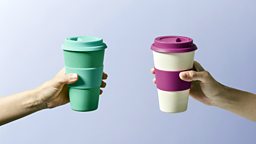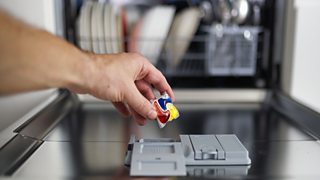Which insulated cups are better at keeping your drinks hot?
There's nothing more invigorating than a hot cuppa in the morning – and nothing more disappointing than when your drink has gone cold. So which types of insulated cups are most likely to keep your brew warm long into the day?
In this episode of 成人快手 Radio 4's Sliced Bread, presenter Greg Foot is sipping his way through an array of vessels. Listener Raffi wants to know which cup will keep his drink warm during his morning commute, while listener Catherine is interested in a durable cup that will survive her busy school day. Greg is joined by chartered physicist Dr Michael de Podesta and Which? scientific advisor Kamisha Darroux to dip into the world of insulated cups.
Here are five things to keep in mind when buying insulated cups…

The typical ceramic mug keeps drinks warm for half an hour
To create a gauge for how good an insulated cup really is, Michael decided to measure them against a standard ceramic mug filled with 300ml of boiling water. Though preferences will vary from person to person, Michael estimated that “the sippable temperature is about 75°C, then [the drink] becomes just right at about 62°C, and it’s too cool… to want to drink below 50°C” for most tea and coffee drinkers. For the ceramic mug, it takes 5 minutes to be sippable, 15 minutes to be just right and another 15 minutes to get too cool. That means as a baseline, insulated cups need to beat 30 minutes of warmth!

Reusable plastic cups (like the ones you can buy from your local café) are the basic improvement on a classic mug. The cups are made from simple polypropylene, perhaps with a sleeve to keep your hands safe. If you keep the lid on, these reusable cups keep drinks warm for an hour – twice that of the ceramic mug without any lid .
Advanced insulated cups use multiple walls to trap heat in
To push beyond the limitations of basic cups, we must get creative. The most common innovation is double-walled cups. These vessels usually use two stainless steel walls with a vacuum-sealed space in-between to reduce the amount of heat escaping through the sides of the cup (although some heat will still slowly escape via radiation). A premium example of double wall technology is the Chilly’s mug (£24), which Michael found could keep drinks warm for 4 hours – eight times longer than a ceramic mug!
The rocket scientist-designed BURNOUT mug (around £50) goes further, not only keeping your tea or coffee warm, but initially cooling it more quickly. The idea is to get to the ‘Goldilocks’ drinkable temperature range and stay there. These cups are triple-walled – between the two innermost walls is a packet of wax that melts when the hot drink first fills the cup. The wax then slowly solidifies again over time, releasing its heat back into the drink and keeping it warm. The BURNOUT mug keeps hot drinks in the Goldilocks range for a full 2 hours.
If you need absolute control over your drink temperature, certain ‘smart mugs’ like the Ember travel mug allow you to set the exact temperature of your drink and keep it there for a full 3 hours, thanks to adjustable electric heating. And all it will cost you is a ‘cool’ £200!
Smart techniques to keep your drink warmer for longer
Shelling out for an expensive mug might not be worth the price unless you really understand what factors affect heat loss. Some factors are more obvious. For example, like the fact that the temperature of the outside environment determines how quickly your drink cools off. Similarly, insulated cups are only useful if you keep the lid on! Exposing a drink to the open air allows for additional heat loss through convection (air taking heat away) and evaporation (water taking away heat as it turns into steam).

There are some great value cups in the middle range, so you don't necessarily need to spend a lot of money.Which? scientific advisor Kamisha Darroux
There are some neat extra tricks to extend the effect of your cups, however. Firstly, if you’re in for a long haul, try to load up as much liquid as you can. Michael explains that a cup with more liquid “helps it stay warm just because there’s a bigger thermal mass”. Secondly, before filling your mug, rinse it with hot water. This will warm up the cup pre-emptively, preventing some small loss of heat when first filled with your drink (although the gain here might be minimal).
Insulated cups aren't just about effectiveness but usability as well
While it can be impressive to have a cup that electrically heats your tea, it might not be practical. Michael advises that “a user needs to find out what the role of the mug is going to be in their life”. To that end, Kamisha and the consumer testing experts at Which? put the full array of insulated cups through their paces.
Compared to other items on the market, insulated cup brands are generally trustworthy. Cups that claimed they were leak-proof were almost always so even after multiple washes. Additionally, Kamisha used thermal imaging cameras on the cups to verify there were no defects in construction leading to excess heat loss. In fact, even the cheapest cups were surprisingly durable even after being dropped from significant heights!
There were, however, a couple factors for buyers to be aware of. Between push buttons, spouts and twist-and-locks, the mouthpiece for your cup can be surprisingly varied. Apart from personal preference, you should avoid openings that can easily trap liquid. When liquid like milk dries, the sour odour will impact your drink’s taste. You could clean the cup to fix this, but that raises another concern – not all insulated cups are dishwasher safe. Washing by hand is the safest way to ensure that water doesn’t get between the double walls and ruin that layer of vacuum insulation. If you can’t be bothered hand washing, opt for something like the Yeti stainless steel tumbler instead which claims to be dishwasher-safe.
'BPA-free' isn't just marketing talk, it's a genuine health concern
Many modern insulated cups come with the label ‘BPA-free’. Kamisha explains why companies are so eager to make this claim: “BPA is a chemical called bisphenol A which is particularly used in the production of plastic… some results suggest it could be harmful to… the brain, or it could disrupt hormones” at high enough doses. Related chemicals BPS and BPF are similarly concerning, and some insulated cups will exclude these as well. Alternatively, a simpler solution is to stick to cups and mugs made of stainless steel. These can sometimes leave you with a slightly metallic taste in your mouth but are generally BPA-free.
Ultimately, most of your choice will come down to personal preference and, of course, price. Kamisha “found some great value cups that are in the middle range… so we don’t necessarily need to spend a lot of money to get a great cup”. Figure out what you’ll be using your cup for, and you’ll have a product that really is better than sliced bread!
To find out more about durability and how these cups compare to traditional thermal flasks, listen to the full episode on 成人快手 Sounds.
The information contained in this article was correct at the time of broadcast on 12 September, 2024.

More articles from Sliced Bread
-
![]()
Are expensive face creams worth the money?
Greg Foot delves into the world of ointments and creams.
-
![]()
Are expensive dishwasher tablets worth the money?
Sliced Bread looks at the range of washing products out there.
-
![]()
Which pots and pans are best for your kitchen?
Greg Foot heads into the kitchen to investigate our cookware.
-
![]()
Are expensive sports bras worth the money?
Can one sports bra really suit all sports?





